Are you considering buying a Baltic Bambi Lifejacket for your baby or toddler so you can take them sailing? We tested ours extensively with our daughter between the ages of three months to two and a half years old while living aboard our sailboat. Read on to find out what we think of it.
One of the more obvious things you can do when going sailing on a boat is to wear a life jacket in case you fall overboard. It will greatly increase your chances of staying afloat and being rescued, especially for babies and toddlers who can't swim yet.
Our daughter has been a boat baby since she was born (she was almost born onboard our sailboat!). She moved aboard at only 18 hours old. At the time we were berthed in a marina and her first trip in a dinghy was at three months old while wearing her lifejacket. She wore it regularly until she was two and a half years old.
Baltic Bambi Lifejacket: Important Features
- Designed for young children (3 -12 kg)
- Buoyancy 100 Newton (classed as a lifejacket)
- Quickly turns to a safe back position (the Bambi design offers faster-turning properties than more traditional waistcoat style lifejackets)
- Contains extra soft and flexible Airex® foam (solid buoyant material)
- Crutch strap is included
- Has retro reflectives for extra visibility
- Whistle included
- Fleece lined neck (and extra soft material all over)
- Grab handle on the collar
- Adjustable so it comfortably fits all weights (3-12 kg)
- Obvious choice for those that can’t swim
- 5-year guarantee
- Available in 3 colours (pink, orange, and yellow)
- Designed in Sweden
- Made in Europe
- CE-approved
What’s The Difference Between a Lifejacket and a Buoyancy Aid?
A lifejacket is designed literally to save lives.
You should wear one whenever you are near water but don't intend to go in.
It will ensure anyone who falls into the water is turned onto their back as quickly as possible and make sure their head is kept clear of the water by using extra buoyancy around their neck. It will help to keep you afloat, your airways clear of water, and your head supported until you can be assisted. This happens whether the person is conscious, unconscious, or unable to swim. They are difficult to swim with while wearing.
A lifejacket can be inflatable or be made of inherently buoyant material (usually foam) and always have a carrying capacity of at least 100 Newtons (100N).
You can get different classes of lifejackets depending on the conditions they'll be used in from 100N to 275N. The higher the number, the more extreme the weather conditions they can be used in while still keeping you afloat.
A buoyancy aid is designed to help keep you afloat but it won't help if you end up face down in the water, nor does it have as much buoyancy as a lifejacket. It is not designed to turn you over and get your airways clear of the water or support your head. It will 'aid' you but not necessarily save your life.
Buoyancy aids are rated to 50 Newtons and are suitable to be used in protected waters.

All wearing our lifejackets in our dinghy. Dave and I are wearing inflatable lifejackets, Erin is wearing her solid foam Baltic Bambi Lifejacket.
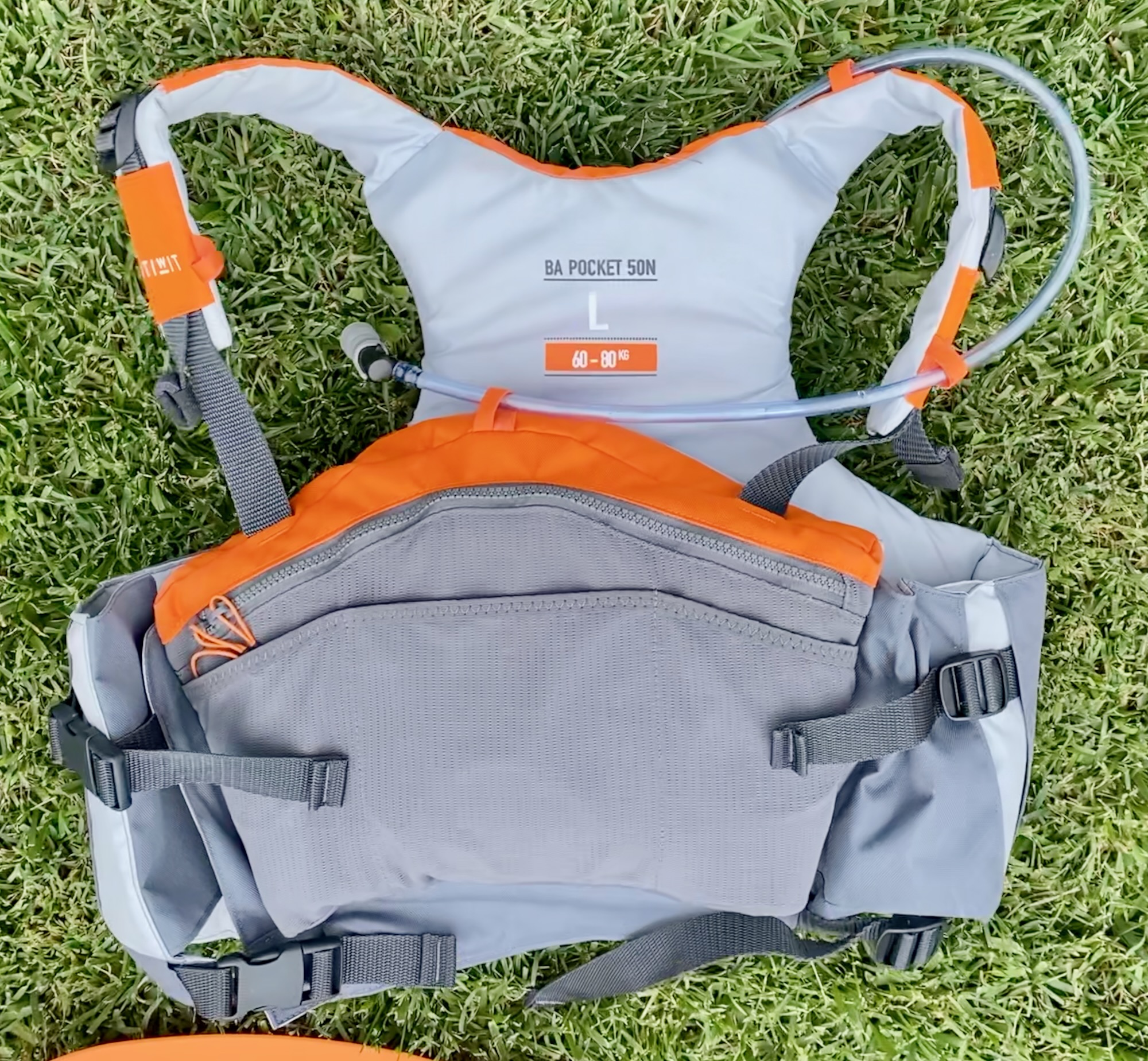
This was a buoyancy aid we bought for Dave to wear while kayaking. It has some buoyancy but no where near as much as a lifejacket. Also, you can see that it won't help keep his face out of the water. It is much easier to swim in a buoyancy aid than a lifejacket as it's more compact.
Lifejackets and Buoyancy Aids Have Different Purposes
Buoyancy aids should be used by those who expect to spend time in the water while taking part in watersports such as kayaking, canoeing, dinghy sailing etc. You need to be able to swim and be conscious throughout.
It will help keep you on the surface of the water if you go in but you'll have to control where your face is as it won't turn you onto your back. You'll be able to swim while wearing one but it must be fitted correctly so it doesn't become a hindrance or a hazard.
It must be snug to your body to minimise the chances of it riding up over your head. If it has a crutch strap, make sure you wear it as it will prevent it from rising up.
Lifejackets should be worn when sailing or motor boating (or any other activity near water) and you don't expect to be in the water. If you end up overboard then your day has gone very wrong.
What’s The Difference Between an Inflatable Lifejacket and One Made of Solid Foam?
Inflatable lifejackets are less bulky to wear and contain an inflatable bladder that is filled with CO₂ when submerged under water or deployed manually using a pull cord.
They are lightweight, comfortable to wear, and very buoyant once deployed. Inflatable lifejacket manufacturer 'BlueStorm' say "more buoyancy, less bulk".
They are not recommended for those under 16 years of age or under 80 lbs (~36 kg).
Once the CO₂ cartridge has been used to inflate the lifejacket or it becomes damaged, it must be replaced before the lifejacket can be used again.
If you are taking part in an activity where there is a high chance you'll end up in the water, for example; kayaking, wakeboarding, small dinghy sailing etc, then it is not recommended you wear an inflatable lifejacket as you'll be restricted in your movement once it has been deployed.
A solid foam lifejacket does not have an inflatable bladder. The lifejacket is made of a solid foam material and is ready to save your life as soon as you put it on as the foam is the buoyant material that allows you to float.
It is good for all ages, sizes, and regardless of swimming ability. It is ideal for most water activities.
However, they aren't always as comfortable as inflatable lifejackets and can restrict your movement when wearing one. They can be hot to wear in the summer.
What Should Babies, Toddlers and Young Children Wear?
All babies, toddlers and young children MUST wear foam lifejackets.
Inflatable lifejackets are not suitable for those under 16 years of age.
Young wearers need something that will allow them to float without relying on a CO₂ cartridge to inflate their lifejacket. If the CO₂ canister fails to deploy, they are unable to rectify the situation themselves by manually deploying it or blowing into a tube to inflate the bladder. This would render the lifejacket useless and would have devastating consequences.
I'll repeat it again as it is that important: all babies, toddlers and young children MUST wear foam lifejackets.
When you choose a foam lifejacket such as the Baltic Bambi Lifejacket, you must ensure that is is appropriate for the weight of your child.
Never buy a lifejacket that they can 'grow into'. It must be a snug fit, properly fastened and adjusted to their body to be effective and do its job of saving their life should they have the misfortune of entering the water.
Who Is The Baltic Bambi Lifejacket For?
The Baltic Bambi Lifejacket has been designed for very young children weighing between 3 - 12 kg.
For those of you who use the Imperial system, 3 kg is 6 lb and 9.8 oz, and 12 kg is 26 lb and 7.3 oz.
To give you an idea of an age range, Erin would have been able to wear the lifejacket from birth.
We first used the Baltic Bambi Lifejacket with her when she was three months old for a short dinghy ride so we could see how she coped ready for when we left the marina at the end of our winter contract.
In all honesty, she wasn't a big fan at that age but to be fair, it was cold as it was February so I'll let her off.
We ended up staying an extra month in the marina thanks to COVID-19 as we were told once we left, we wouldn't be allowed back in. We were supposed to have left at the end of March 2020 but the UK was in lockdown at the time so we decided it was probably best to stay put.
It meant that Erin was nearly six months old by the time we left the marina and started needing to have dinghy trips ashore with her. At that age, she was a lot happier to wear her lifejacket.
Erin was able to continue wearing her Baltic Bambi Lifejacket until she was around two and a half years old as it had a good level of adjustment. She is small for her age though so you may find your child grows out of it sooner. We were able to make it snug for her to wear despite the large difference in size between the two pictures.
We were able to get two good years' worth of use out of it and it is still in good condition, so, if we had a second child, I'd be happy to use it with them too.
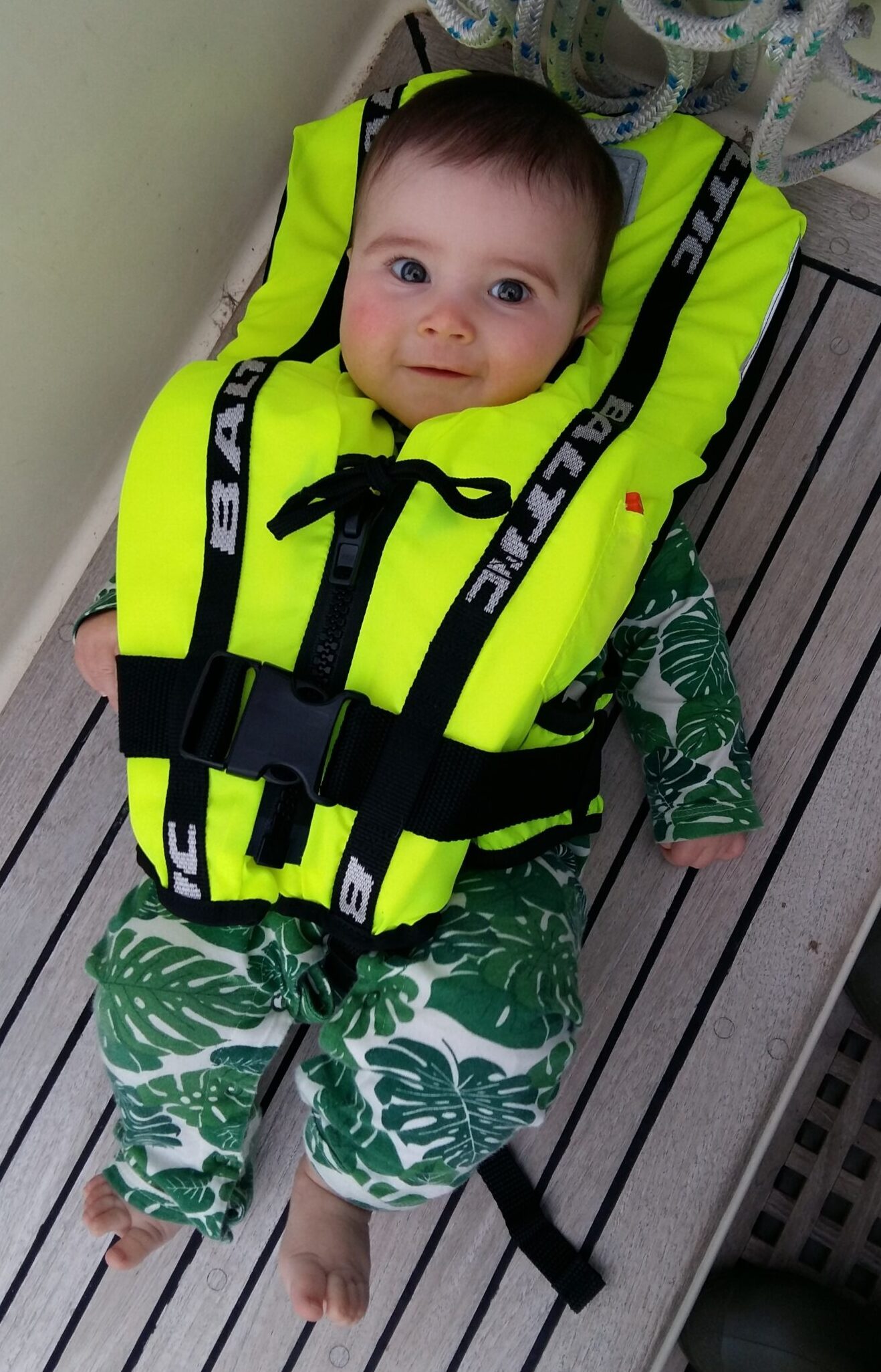
Erin at around six months old wearing her Baltic Bambi Lifejacket - much happier than at three months old! You can just see the orange whistle poking out the top of its pouch on Erin's left side.
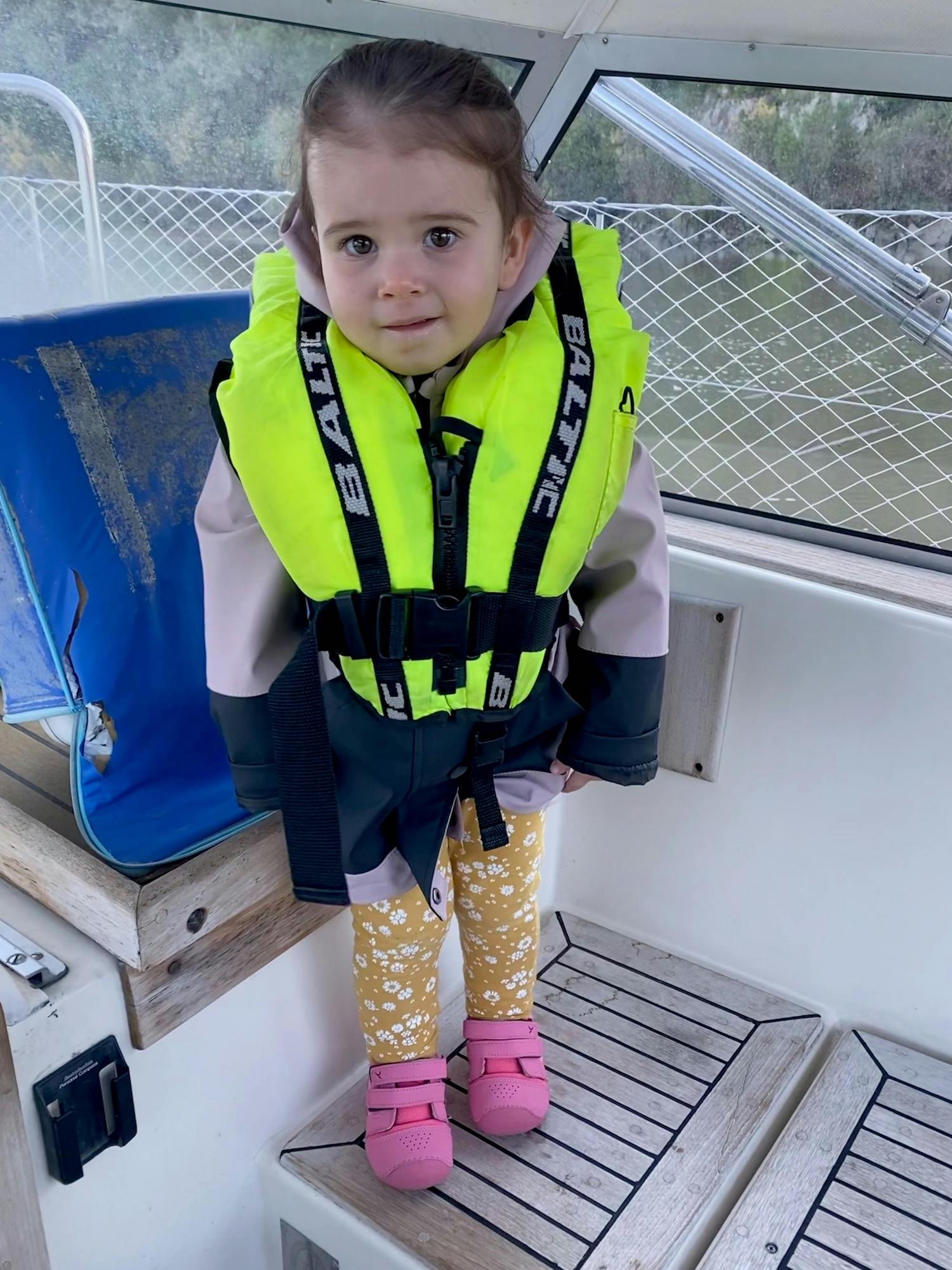
She still fitted into her Baltic Bambi Lifejacket as a toddler. She was around two and half years old here.
What Guarantee Does the Baltic Bambi Lifejacket Come With?
Baltic states on their website that they never compromise on quality; it's in their DNA. They proudly offer a 5-year warranty on all their lifejackets.
What Design Features Does the Baltic Bambi Lifejacket Have?
Buoyancy
The Baltic Bambi Lifejacket was designed to be worn by very young children.
Due to the amount of buoyancy it has on the front, it quickly turns the wearer to a safe back position and helps to keep their face well-clear of the water. The Bambi design offers faster-turning properties than more traditional waistcoat-style lifejackets.
It doesn't matter if your child isn't able to swim yet. Lifejackets such as this one are designed to keep swimmers and non-swimmers alive regardless.
Soft Materials
The lifejacket is soft to the touch and has a fleece-lined neck to ensure comfort as well as safety when worn.
It has a little bit of squish and the neck collar adjusts its position as the child grows to increase comfort when being worn while still keeping their head clear of the water.
Retro Reflectives
There are multiple retro reflectives fitted to the lifejacket around the neck collar to increase visibility in low light if a child were to go into the water.

Large retro reflectives on either side of the neck collar. There is also one on top, which can be seen in the photo further up the article of Erin as a baby (it's just behind her head). You can also see how much adjustment there is in the webbing strap around her waist allowing for lots of growth.
Adjustable
The straps on the lifejacket had a lot of adjustment in.
The webbing strap around her middle made sure the lifejacket was a snug fit, despite her growing and the crutch strap was also able to be adjusted as she grew in height and her torso got longer.
Grab Handle
An essential part of the Baltic Bambi Lifejacket that we used regularly to get Erin on and off the boat into the dinghy. It is very sturdy and made of webbing.
It was also very handy for attaching a hat tether to so whenever her hat flew off in the wind, we didn't lose the hat.
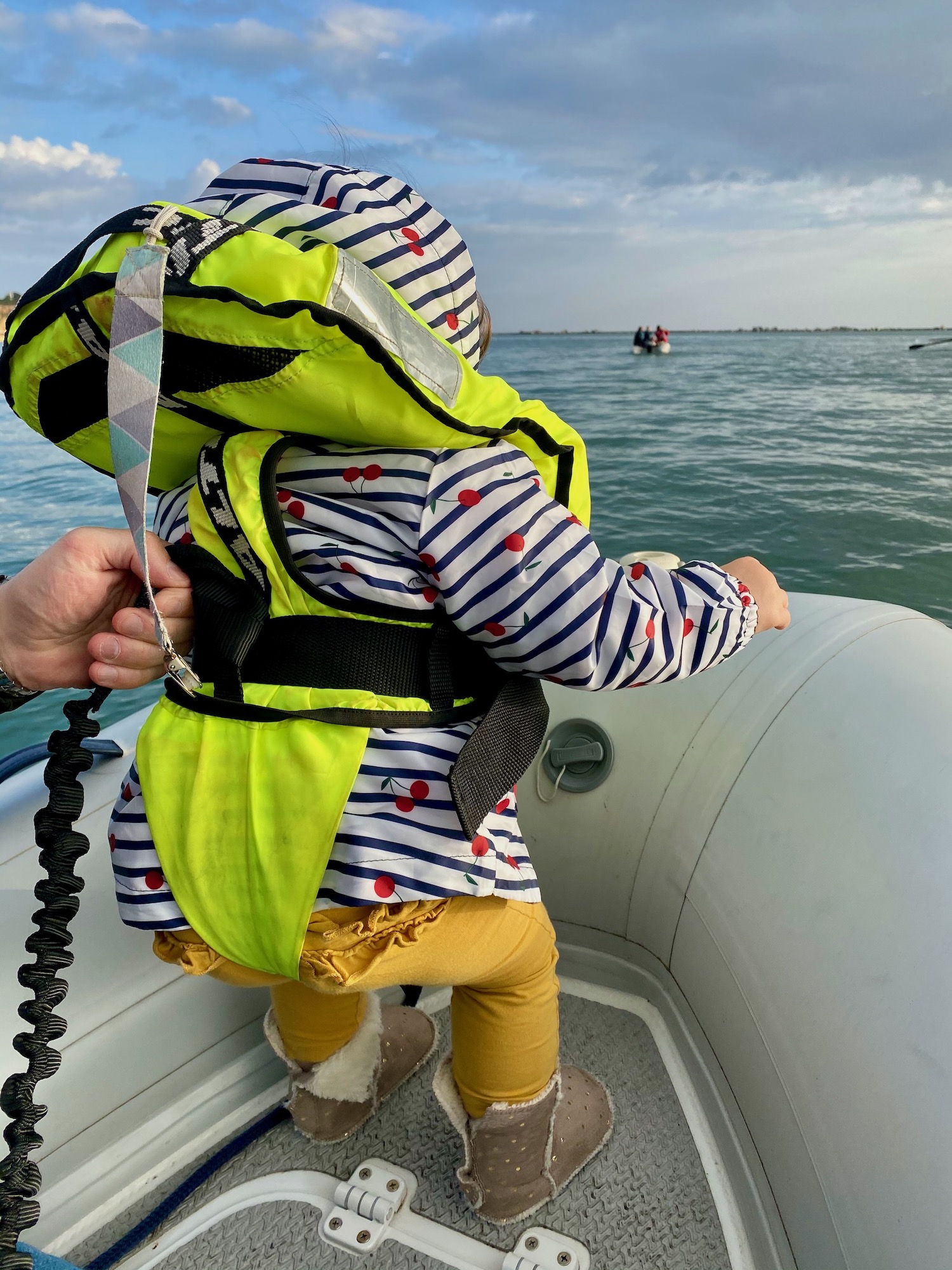
You can see the grab handle at the top of the Baltic Bambi Lifejacket where we also attached a hat tether line. The crutch strap is wide at the back which increased the comfort for Erin while she was wearing it. It also made it easier to lift her while she was wearing the lifejacket.
Why Is a Crotch Strap Important?
During our time living at anchor up the Guadiana River between Spain and Portugal, we regularly went ashore using the dinghy. The river had strong currents and had a lot of sediment in the water so visibility in the water was almost non-existent so you really didn't want to fall in, especially without a lifejacket or buoyancy aid on. Unfortunately. while we were there someone fell in one night while trying to go from their dinghy to their boat and his body was discovered a few days later. It was a stark wake-up call.
There was a local kayaking club just North of Alcoutim and we'd see kayaks going past the boat each week when they had their meets. I was going ashore one day and beginning my approach to tie up alongside the pontoon when I saw someone fall into the water from their kayak. They were very close to the pontoon but unfortunately, it was too high up for them to climb onto from the water. I offered help but he refused so I tried to get the attention of the instructors that were in kayaks nearby.
He was wearing a buoyancy aid but it seemed to be quite loose and the longer he was in the water, the more it was beginning to ride up towards his head as he was being swept along by the current towards a boat moored alongside the pontoon.
At this point, it was clear that if he didn't accept help from me, he was going to be swept between the boat and the pontoon and the buoyancy aid just kept getting higher and higher so I got as close as I could and helped him climb into our dinghy.
Once he was aboard, it was clear why his buoyancy aid had been causing problems. It wasn't tight enough and he wasn't wearing the crotch strap.
The crotch strap is there to prevent the lifejacket or buoyancy aid from rising up above your head and it slipping off rendering it useless.
ALWAYS wear the crotch strap!
When Should Your Child Wear a Lifejacket?
To help keep your child safe, they should wear a lifejacket whenever there is a risk of them falling overboard or going into water.
For us, this was whenever Erin was on deck (we fitted extra safety netting onboard but still felt happier when she was wearing her lifejacket), going for a ride in the dinghy, being transferred from the boat to the dinghy, and walking on marina pontoons.
We were hyper-safety conscious with her onboard, especially once she started walking and climbing.
However, it wasn't appropriate for her to constantly wear a lifejacket while on board if she was safely below decks, especially when we weren't moving. We made sure the companionway boards were always in so she couldn't climb up the steps and out into the cockpit by herself, and she was never allowed to be outside in the cockpit or on deck without one of us with her at all times.
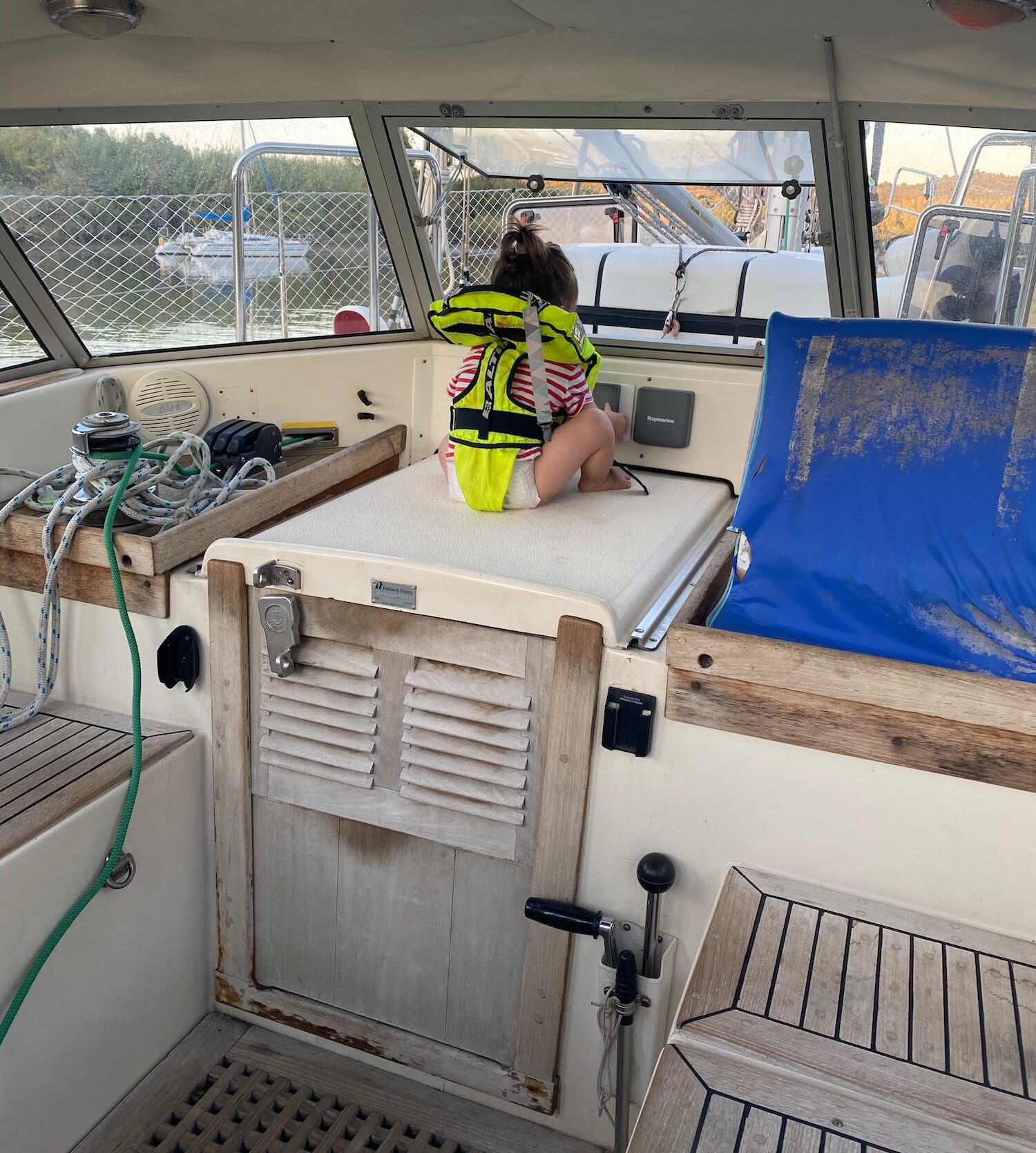
Erin loved to be out in the cockpit looking out at her surroundings. Whenever she was outside, she wore her Baltic Bambi Lifejacket and one of us was with her at all times. You can see the safety netting we fitted in the background.
How Do You Get a Young Child In and Out Of a Dinghy Or On and Off The Boat Safely?
First of all, they must be wearing a lifejacket that is correctly fitted. Everything must be done up and secured. For the Baltic Bambi Lifejacket, that means the front zip, the plastic side buckle, the bow at the top of the zip, and the crutch strap are all done up securely.
DO NOT forget the crutch strap. That is vital for the next part.
We'd do a check 'lift' in the cockpit to make sure it was secure and she wasn't going to drop out the bottom.
Either Dave or I would then climb down into the dinghy which was either alongside or at the stern of the boat.
Whoever was left on deck would then use the grab handle on the collar of the lifejacket to pick her up and lift her down into the dinghy where she was quickly grabbed and put down safely into the dinghy. This is why the crutch strap is absolutely vital.
Erin quite enjoyed doing this, she has since shown she likes flying so that may be why...
To get her back on board we did the opposite.
One of us would secure the dinghy alongside and climb on deck. Whoever was left in the dinghy would pass her up in one swift movement using the grab strap to the person on deck who quickly got hold of the grab strap and put her down safely on deck.
We'd always make sure we held onto her until she was safely in the cockpit before transferring her down below deck.
If we were alongside in a marina then we'd do the same but we'd pass her to whoever was on the pontoon rather than down to the dinghy.
We had a lot of confidence in the quality of the Baltic Bambi Lifejacket and we felt happy doing this manoeuvre on a regular basis. It has excellent build quality and was strong and sturdy enough to deal with containing and lifting a small child on and off the boat regularly.

Erin absolutely loved going for dinghy rides and always wore her Baltic Bambi Lifejacket. She still talks about dinghy rides now we're back on land.
How Much Does The Baltic Bambi Lifejacket Cost?
At the time of writing this article, it is listed for sale for £70/€80 on the Baltic website.
To see the current price, visit the Baltic Bambi Lifejacket information page on their website.
Our Final Thoughts on the Baltic Bambi Lifejacket
We were actually given the Baltic Bambi Lifejacket as a gift from friends when Erin was born. However, after giving it plenty of use over two years, I'd happily have paid £70 to buy it ourselves.
It's a very well-made, sturdy but comfortable to-wear lifejacket that our daughter happily put on whenever it was necessary for her to wear it.
It gave us a lot of confidence that Erin would be safe and protected whenever she wore her Baltic Bambi Lifejacket in case she fell into the water.
I'm more than happy to recommend this lifejacket to others who want their baby or toddler to be safe around the water.
Where Can I Go To Find More Information About Baltic and Their Lifejackets?
Baltic kindly supplied me with the following links for Families Afloat readers to find out more about the business and their products.
Baltic Environmental Initiative with more information here too
Understanding the art of layering 24/7 365 days a year

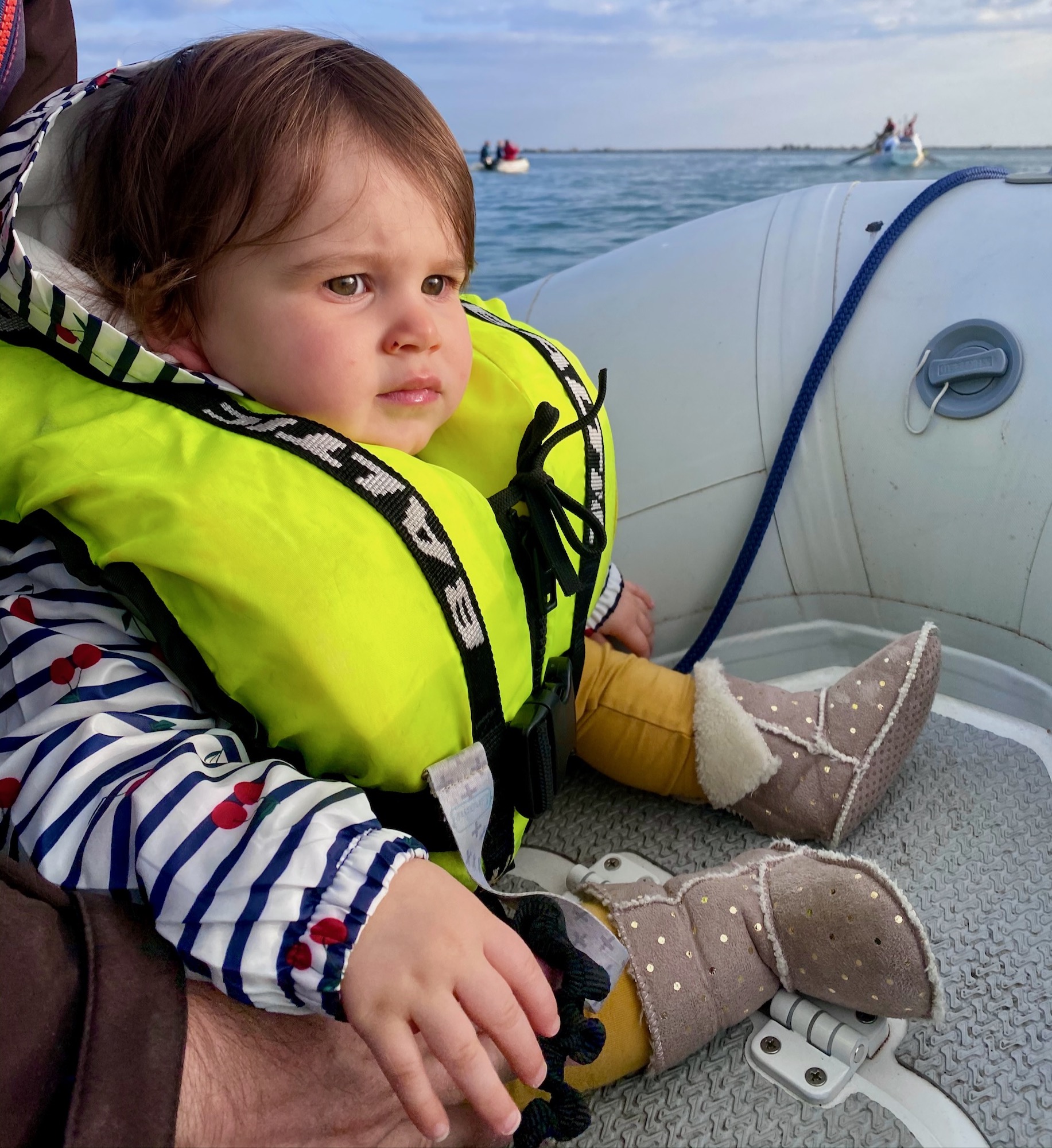
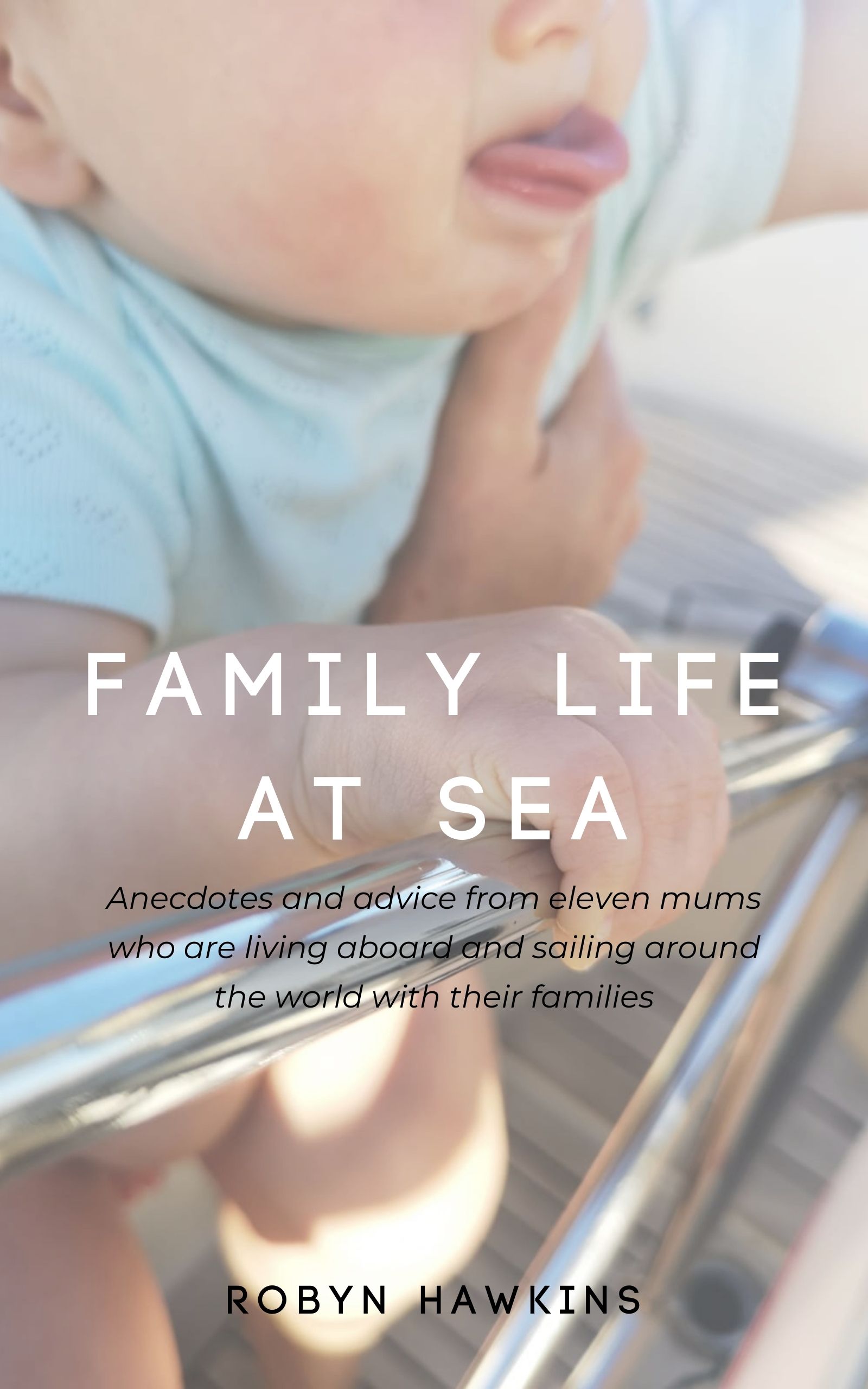
0 comments